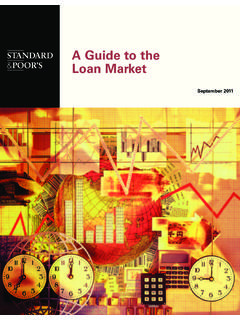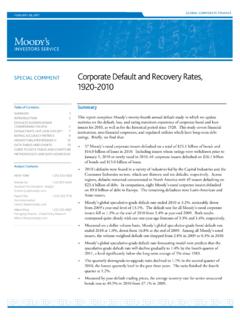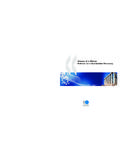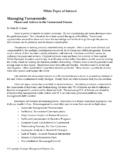Transcription of Global Economic Outlook to 2017 - Country risk
1 1D&B s Global Economic Outlookto 2017 Around the World Regional Insights, Upgrades and DowngradesNorth America (US, Canada) and Mexico Latin America Europe Eastern Europe and Central Asia Asia Pacifi c Middle East and North Africa Sub-Saharan Africa 2 Global Economic Outlook : Where We AreThe recovery from the 2008 2009 recession is the slowest and most problematic of the past The recovery from the 2008-2009 recession is the slowest and most problematic of the past century, highlighted by changes in D&B s Country risk ratings: 56 of the 132 countries ( ) rate worse than in October 2009 when the recovery started, while only 23 ( ) rate better. This level of downward movement is extremely unusual for a recovery and reflects the unique circumstances of this cycle versus prior recoveries. Indeed in 2012, three years into the recovery , D&B downgraded 32 countries the third highest number of downgrades in one calendar year while only upgrading Risk Insights The recovery from the 2008 09 recession remains the most challenging in the past century.
2 Deleveraging in the private and public sectors remains an inhibitor to growth throughout the forecast period. These pressures are offset by substantial improvement in the health of the corporate sector. Structural imbalances in key emerging economies are potential headwinds. The macro-economy, fiscal imbalances, and continued quantitative easing constitute high risks. New political risks have arisen as a result of the Arab Spring. The recovery will be uneven across regions and in saw the third highest number of downgrades ever. 2012 was slightly more challenging than first anticipated, when Global growth was predicted to be a modest Actual results indicate growth closer to 2%, a subdued pace by any measure. Headlines confirm the European Outlook eroded throughout the year, driven by the ongoing Eurozone saga which in turn fuelled Global under-performance.
3 China s exposure to reduced European demand resulted in the Asia/Pacific real-GDP growth forecast falling by percentage points (pp) to In turn, Chinese demand for commodities declined throughout the year, impacting the growth forecasts of commodity rich countries. Given these factors, most regions ended 2012 below expected growth levels: Regional forecasts for Latin America and the Caribbean fell from to ; Eastern Europe and Central Asia from to ; the Middle East and North Africa from to ; and Sub-Saharan Africa from to GDP Growth20112012e2013f2014f2015f2016f2017f North America & Europe & Central East & North growth to pick up slowly through 2017 , but downside factors still remain. After the 2012 slowdown Global Economic growth is expected to pick up gradually through 2017 . Nevertheless, growth is still expected to be lower than in the five years prior to 2008, and a number of concerns still weigh heavily on these forecasts.
4 In a regional context, the forecasts highlight different growth patterns. The table above highlights the disparities in trends across the regions, with certain regions experiencing further slowdowns before growth approaches near-normal levels in 2017 . Thus, slowdowns are anticipated in North America in 2013 and 2015, Asia/Pacific in 2016, and Latin America in We Are Going: 2013 to 2017 The healing process following the 2008 09 recession will continue to make slow, erratic progress over the next five The healing process following the 2008 09 recession will continue to make slow, erratic progress over the next five years. The significant restructuring of the US private sector is a chief driver, which, according to D&B s unique data, is resulting in slowing bankruptcies across most sectors and improved payment performance. Furthermore, the boom in unconventional gas and oil in the US is driving down energy prices, boosting business confidence and supporting growth in key sectors like manufacturing.
5 But risks remain. Despite this cautious optimism a number of risks remain, namely: High levels of debt, particularly in the public sector; Unintended consequences of the unprecedented monetary easing policies; Unravelling of sectoral imbalances, particularly in emerging markets; and Political risks associated with the transformation of countries to new governmental systems ( , Arab Spring).Total debt remains Total debt levels in many developed economies have expanded considerably since 2000, with some of the worst offenders being Japan (over 630% of GDP in Q2 2012), the UK (556% of GDP in Q2 2012), and France (over 510% of GDP in Q3 2012). Germany (around 350% of GDP in Q2 2012) is one of the few OECD countries to have controlled its overall debt levels across the period..with household debt still growing in certain When broken down into household, corporate, and public sector debt, a more nuanced picture emerges.
6 Household debt is still growing in France ( of GDP in Q2 2012), Italy ( of GDP in Q2 2012), and Canada ( of GDP in 2012). However, significant deleveraging has taken place in the US (down from a peak of of GDP in Q2 2009 to of GDP in Q3 2012) and the UK (down from a peak of of GDP in Q1 2009 to of GDP in Q3 2012). In Spain household debt has peaked and is falling slowly. In contrast, German household debt has fallen consistently since 2000 (now standing at of GDP), and Japanese household debt has remained relatively static ( of GDP)..and non-financial sector debt falling significantly in the US and When looking at the non-financial sector, a similarly confused picture emerges. French companies ( of GDP in Q2 2012) are still building debt, while Japanese (down from of GDP in Q2 2008 to of GDP in Q3 2012), UK (down from of GDP in Q4 2008 to of GDP in Q3 2012), and Spanish (down from of GDP in Q2 2009 to of GDP in Q2 2012) company debt appears to have peaked in 2008-09 and is now slowly falling.
7 German, Italian, and Canadian company debt levels have been relatively static since the crisis erupted..but public sector is the main cause for concern. However, the increase in public sector debt since 2008 is most concerning, as governments ramped up spending to boost Economic growth. Furthermore, as the table 4below indicates, the problem is not only in advanced economies; emerging economies to a lesser extent have seen their fiscal positions worsen. As a result, government spending in many countries will remain constrained and tax levels high over the next few years as governments attempt to balance their books. That, in turn, will constrain growth in economies such as the US, where private sector restructuring has and central banks have used quantitative easing (QE) policies, allied with record low interest rates. In five short years the Bank of Japan has increased total assets by In the US, the Federal Reserve s assets have increased by , while total assets of the Bank of England have risen by Finally, the European Central Bank s total assets rose by The unintended consequences of quantitative easing policies are While debate surrounds the short-term success of such policies, longer-term unintended consequences are more concerning, including excessive risk-taking.
8 Already, yields between high-risk bonds and US treasuries are narrowing, stock markets have boomed in many countries, speculative activity in commodity markets are keeping prices higher than fundamentals would dictate, and distortions mar the foreign currency markets. Currencies in countries using QE remain artificially weak, boosting export potential. Other countries are finding their currencies strengthening from increased capital flows, thereby weakening their export competitiveness. Importantly, exchange rate distortions are boosting beggar-my-neighbor trade protectionist policies, threatening Global growth..which encourage excessive risk-taking, distorting capital markets and fuelling asset , inward capital flows to emerging markets are creating asset bubbles fuelled by easy access to cheap credit. In Turkey domestic bank lending to the private sector has increased from of GDP at end-Q3 2008 to of GDP at end-Q3 2012, and Brazil has seen similar growth.
9 These flows are further distorting existing sectoral imbalances and creating significant policy challenges for governments. For example, in the four years from end-Q3 2008 to end-Q3 2012, China s domestic banking claims on the private sector have risen from of GDP to of GDP, fuelling a boom in home prices. While home prices have unravelled since early 2011 (see chart below), concerns linger that a collapse in home prices similar to that experienced in the US six years ago would have major implications for the Global tensions raised by the ongoing Arab Spring have produced new risks. Finally, the Arab Spring sparked by high levels of poverty and unemployment and exacerbated by cutbacks in government spending has produced significant risk. These socio- Economic factors could lead to similar situations in countries outside the Arab world as governments fight to rebalance their budgets while appeasing their populations.
10 The transition to democracy is by no means certain in Egypt, Libya and Tunisia, while the civil war in Syria continues unabated. Furthermore, the situation in Lebanon, Iraq, Jordan, Algeria, and Yemen is anticipated to deteriorate over 2013. Regional stability is important in maintaining downward pressure on oil prices and Global energy prices, not to mention ensuring supply-chain continuity. Fiscal deterioration20062012 ChangeAdvanced Economies (% of GDP) Economies (% of GDP) (% of GDP) (% of GDP) of countries in excess of of GDP1230185 Key Observations Global rebalancing is underway. The US business sector is healthy and has become leaner and meaner. In addition, enablers such as the energy boom in the US are putting downward pressure on energy prices. However, macro- Economic risks remain largely due to fiscal issues in developed markets and risks in emerging markets.







